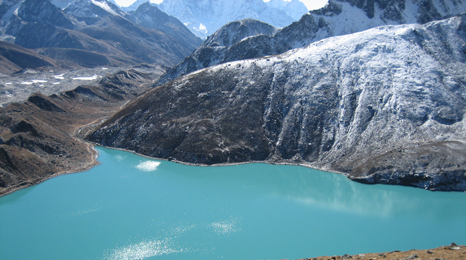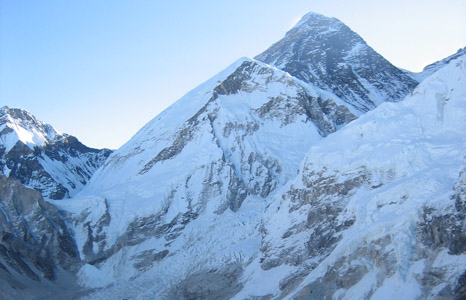Glaciers Feeding Ganga And Indus Will Decrease
As Himalaya Glacial Melt Set To Peak By 2070
By Countercurrents.org
12 August, 2013
Countercurrents.org

Himalaya glaciers are vital sources of fresh water for Bangladesh , China , India , Nepal and Pakistan
The size of the glaciers in the watershed of the Indus and the Ganges will decrease during the 21st century as Himalaya glacial melting will peak around 2070, said scientists. The phenomenon will impact Bangladesh , China , India , Nepal and Pakistan .
An article by Kieran Cooke [1] said:
The river systems fed by the Himalaya glaciers are a vital source of water, food and energy for hundreds of millions of people downstream in the adjoining areas.
Trying to predict the impact of climate change on glaciers in such a large and inaccessible area as the Himalayas – with research made more difficult by bitter intra-regional rivalries – is no easy task.
The article produced by the Climate News Network said:
While some studies say rising temperatures in the mountains and the melt of glaciers will lead to falling river levels downstream and drought in what is one of the most densely populated regions on the planet, other reports paint a more sanguine picture.
In a study in the journal Nature Geoscience, scientists say that in two of the region's most important river basins – the Ganges and the Indus – water levels are unlikely to drop over the next century.
This contrasts with earlier studies – including one by the same authors – suggesting water levels in these rivers would drop significantly by 2050, threatening the livelihoods of millions.
The article carried by Responding to Climate Change on said:
The new report, Rising river flows throughout the twenty-first century in two Himalayan glacierized watersheds, says that in some parts of the Himalayan region, river flow losses as a result of less glacial meltwater will be compensated by an increase in monsoon rains.
The lead author of the report is Dr Walter Immerzeel, a mountain hydrology and climate change specialist at Utrecht University and at present, a visiting scientist at the International Centre for Integrated Mountain Development (ICIMOD) in Nepal .
Four years ago Immerzeel and his colleagues published a report predicting a considerable drop in water levels in the same rivers by 2050.
“We are now using a more advanced glacier model that takes into consideration how slowly glaciers respond to climate change” says Dr Immerzeel.
Marc Bierkens, professor of Hydrology at Utrecht and a report co-author, says the modelling research shows the size of the glaciers in the watershed of the Indus and the Ganges will decrease during the 21st century.
“Yet, surprisingly enough, water discharge in this region is increasing, rather than decreasing. The reasons vary greatly from one watershed to another.”
Rainfall impacts
Bierkens told Climate News Network that the latest research findings were the result of using a more sophisticated ice model together with a new set of climate models and the fact that, especially in the western Himalayas , the increase in rainfall with height is larger than previously thought.
To understand the impact of climate change on river discharge, researchers created computer models of glacier movements and water balance in both the Indus and the Ganges watersheds.
The models indicated that in the eastern watershed – in Langtang in Nepal where the Ganges has its source – the relatively smaller glaciers melt quite quickly but an increase in monsoon rains leads to a growth in water discharge.
In the western watershed – in Baltoro in Pakistan where the Indus has its source – the climate is dryer and colder and has much larger glaciers.
The models show discharges in the area are increasing, mainly as a result of more glacial melting. Such melting, says the study, will peak around 2070 and thereafter drop but will be compensated for by an increase in precipitation.
“While the results of the research predict a somber future for the Himalayan glaciers, they offer some good news for water and food security in India , Bangladesh and Pakistan ” says a report summary.
Everest's glacial retreat

Everest's shrinking glaciers (Pic: Ed King)
Citing researchers' report at the American Geophysical Union's meeting in Cancun , Mexico , another article by Tim Radford [2] said:
Mount Everest , the world's highest peak, is beginning to lose its snow and ice.
After studies of satellite imagery of the mountain and the Sagarmatha National Park the scientists reported:
The Everest region in the Himalayas has been warming, and snow precipitation declining, for the last 20 years.
Everest glaciers have shrunk by 13% in the last 50 years and the snowline has moved 180 meters uphill. As the glaciers dwindle, the rocks and debris they carry are being exposed: the debris-covered sections of the glaciers have increased by 17% since the 1960s.
The article produced by the Climate News Network said:
Once again, the researchers suspect that human-induced climate change may be responsible: this connection however is much harder to establish. But the majority of glaciers in the region are retreating at an ever-faster rate.
“The Himalayan glaciers and ice caps are considered a water tower for Asia , since they store and supply water downstream during the dry season”, said the scientist Sudeep Thakuri.
“Downstream populations are dependent on melt water for agriculture, drinking and power production.”
The Rockies
The article carried by Responding to Climate Change said:
Around 20% of the snow cover in North America 's greatest mountain range has been lost – because of warmer springs in the last three decades.
Scientists from the American Geophysical Union and the US Geological Survey report that they had established a pattern of snowfall in the northern and southern Rockies : when the snowpack was large in the northern Rockies , it might be correspondingly meagre in the southern mountains and vice versa. But since the 1980s, snowpack declines have occurred simultaneously along the entire length of the Rocky Mountains , with unusually severe declines in the north.
Now research has begun to establish the cause. Researchers write in Geophysical Research Letters that, using monthly data collected from 1895 to 2011, they have been able to tease apart the different influences of winter temperatures, spring warming and overall precipitation on the April volume of the snowpack.
“Snow deficits were consistent throughout the Rockies due to lack of precipitation during the cool seasons during the 1930s – coinciding with the Dust Bowl era.
“From 1980 on, warmer spring temperatures melted snowpack throughout the Rockies early, regardless of winter precipitation,” said Greg Pederson of the Northern Rocky Mountain Science Center in Bozeman , Montana .
“The model in turn shows temperature as the major driving factor in snowpack declines over the past 30 years.”
Runoff from the Rocky Mountain snows accounts for 60 to 80% of the annual water supply for more than 70 million people in the western US. The timing of snowmelt affects the levels of water available for crop irrigation and hydro-electric power. It can also influence the risk of regional floods and bush fires.
Tim Radford's article said:
The researchers blame both natural variation – the influence of cyclic Pacific Ocean phenomena such as El Niño and La Niña, for example – and global warming from human activity for the change.
Snowline heads uphill
“Regardless of the ultimate causes, continuation of present snowpack trends in the Rocky Mountains will pose difficult challenges for watershed management and conventional water planning in the American West”, said co-author Julio Betancourt.
Source:
[1] August 12, 2013 , http://www.rtcc.org/2013/08/12/himalaya-glacial-melt-set-to-peak-by-2070/
[2] May 15, 2013 , “Scientists report glacial retreat in Mount Everest region”, http://www.rtcc.org/2013/05/15/scientists-report-glacial-retreat-in-mount-everest-region/
Comments are moderated


